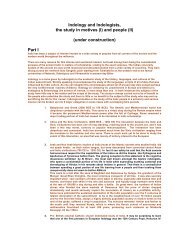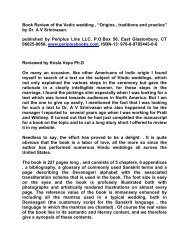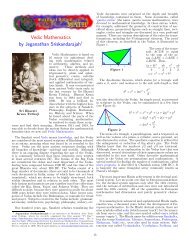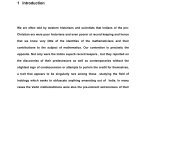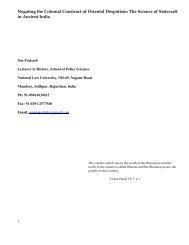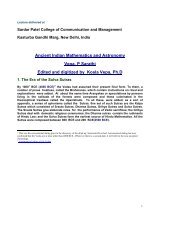The Dhaarmik Traditions - Indic Studies Foundation
The Dhaarmik Traditions - Indic Studies Foundation
The Dhaarmik Traditions - Indic Studies Foundation
You also want an ePaper? Increase the reach of your titles
YUMPU automatically turns print PDFs into web optimized ePapers that Google loves.
that used by Patanjali in the Yogasutras and hence suggests that the Gita predates<br />
Patanjali and maybe even Panini. Whatever be the age of the Gita, it is certain that it<br />
precedes Buddhism and by any standard is of great antiquity and in our opinion is as<br />
old as the 4 th millennium BCE.<br />
5.3 <strong>The</strong> Scripture of Yoga<br />
<strong>The</strong> Gita addresses the discord between the senses and the intuition of cosmic order.<br />
It speaks of the Yoga of equanimity, a detached outlook. <strong>The</strong> term Yoga covers a wide<br />
range of meanings, but in the context of the Bhagavad Gita, describes a integrated<br />
outlook, serenity of mind, skill in action, and the ability to stay attuned to the glory of<br />
the Self (Atman), which is of the same essence as the basis of Being (Brahman).<br />
According to Krishna, the root of all suffering and discord is the agitation of the mind<br />
caused by selfish desire. <strong>The</strong> only way to douse the flame of desire is by<br />
simultaneously stilling the mind through self discipline and engaging oneself in a<br />
higher form of activity.<br />
However, abstinence from action is regarded as being just as detrimental as extreme<br />
indulgence. According to the Bhagavad Gita, the goal of life is to free the mind and<br />
intellect from their complexities, and to focus them on the glory of the Self, by<br />
dedicating one's actions to the divine. This goal can be achieved through the Yogas of<br />
meditation, action, devotion and knowledge. <strong>The</strong> Gita describes the best Yogi as one<br />
who constantly comtemplates God.<br />
Sri Krishna summarizes the Yogas through eighteen chapters. <strong>The</strong>re are four kinds of<br />
Yoga - Raja Yoga or Psycho-Physical Meditation, Bhakti Yoga or Devotion, Karma<br />
Yoga or Selfless Action, and Jnana Yoga or Self Transcending Knowledge.<br />
While each path differs, their fundamental goal is the same - to realize Brahman (the<br />
Divine Essence) as being the ultimate truth upon which our material universe rests,<br />
that the body is temporal, and that the Supreme Soul (ParamAtman) is infinite. Yoga's<br />
aim (nirvana or moksha) is to escape from the cycle of reincarnation through<br />
realization of oneness with the ultimate reality. <strong>The</strong>re are three stages to selfrealization<br />
enunciated from the Bhagavad Gita:<br />
1. Brahman - <strong>The</strong> impersonal universal energy<br />
2. ParamAtman - <strong>The</strong> Supreme Soul sitting in the heart of every living entity.<br />
3. Bhagavan - God as a personality, with a transcendental form.<br />
101



